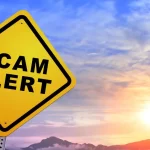This post may contain affiliate links. We may receive compensation when you click on links to those products at no additional cost to you. Read our full disclosure here.
One of the scariest feelings one can experience is finding purchases on a credit card statement that you didn’t make. Even though credit card companies have increased security measures to protect consumers, credit card fraud is still rampant across America and has increased by 44% from 2019 to 2020 according to the Federal Trade Commission (FTC).
In this article, we will discuss what to do if you’re a victim of credit card fraud and found out that someone uses your credit card for online purchases.
What To Do If Someone Uses Your Card for Online Purchases?

1. Call Your Credit Card Company
The first thing you should do if someone uses your card for purchases is to call your credit card company and let them know ASAP. You can find their number on your monthly statements, online account, or even on your phone app. Your credit card company should:
- Cancel your compromised card
- Issue you a new card with a new number
- Remove disputed items on your bill and Investigate the fraudulent charges. Note: All disputes must be put in writing.
The good news is most big credit card companies like Chase and Citi have “zero liability” policies which basically means that you won’t be held accountable for any unauthorized charges. If your credit card company does not have that policy, federal law limits your liability to just $50.
For ATM and debit cards, the maximum liability is:
- $0 if you report a lost debit card before any fraudulent charges were made
- $50 if you report the loss within 48 hours
- $500 if you the loss after 48 hours but within 60 days
2. Contact The Credit Bureaus
Once you’ve ensured that the thief cannot continue using your card for further purchases, you need to contact one of the three credit bureaus (that company must tell the other two) to:
- Set a credit freeze to shut off access to your credit information and the thief can’t go and make changes or create new credit accounts.
- Set up fraud alerts for a year to make sure creditors take more steps to verify your identity before issuing credit.
- Add a victim statement to your credit report so that future creditors will need to call you before issuing credit under your name.
- Get a copy of your free credit report and check for suspicious activity. You’ll need to submit a credit dispute to have the fraud information removed.
Contact info For Credit Bureaus
- Experian.com/help
888-EXPERIAN (888-397-3742) - TransUnion.com/credit-help
888-909-8872 - Equifax.com/personal/credit-report-services
800-685-1111
3. Change Your Passwords
You may not know how exactly your information was stolen. Nevertheless, it is wise to do an audit of your accounts and change your passwords as they may be compromised. While this may seem like a tedious step, having just one password (or just one with slight variations) for all your accounts is a recipe for disaster as hackers just need to hack your password and all your accounts will be compromised.
How To Protect Your Accounts
- I use a free password manager like Bitwarden to generate passwords and store them for easy access across my devices.
- I also use a two-factor authentication app like Authy for my accounts to add another layer of security in case my passwords do get hacked. This basically means that if someone got my password and were to try and login into an account with 2FA, they’ll still need a code that is only accessible by me.
4. Contact The Federal Trade Commission
As credit card fraud is a form of identity theft, the Federal Trade Commission (FTC) can offer assistance to identity theft victims. They do this by:
- Providing you resources on recovery
- Compiles information and statistics to help curb identity theft
- Generate an identity theft report to file a police report or dispute charges
How to Get An Identity Theft Report
There are two ways to get an identity theft report from FTC:
- Fill out this online form at IdentityTheft.gov to report your case and get a recovery plan.
- Be sure to save a copy of this report to bolster your claims of credit card fraud.
- OR call (877) IDTHEFT (877-438-4338)
5. Contact The Police
While some police departments do not recognize credit card fraud as a crime they’re responsible for, it is still important to file a police report because:
- Credit bureaus may not block fraudulent items on your credit report
- A police report will cover you against liability in case someone uses your stolen identity to commit a crime.
Filing a police report is free and here is what you’ll need to provide:
- a copy of your FTC Identity Theft Report from step 4
- a government-issued ID with a photo (eg. driver’s license or passport)
- proof of your address (utility bills, statements)
- any documentation that contains proof of identity theft
- FTC’s Memo to Law Enforcement [PDF]
Remember to get the police report number, date, time, police department, name of the person taking your report, and a copy of the police report as well!
6. Stay On Top Of Your Credit Report
After completing steps 1-4, you need to try to stay on top of things to prevent more credit card fraud. This means you should intentionally monitor your credit card statements and credit card report and check for any suspicious activity and charges.
To check your credit card statements:
- Access your credit card statements either online or by mail and go through each line item of transactions.
- If you spot any unauthorized charges, repeat steps 1 to 4 immediately!
To check your credit report:
- Visit annualcreditreport.com to receive one free official credit report from each of the three credit bureaus.
- You can also use apps like Credit Karma and /or CreditWise to monitor your unofficial credit report on a regular basis.
How To Prevent Identity Theft
Here are some tips to help you prevent identity theft in the future after you’ve learned what to do if you’re a victim of credit card fraud and someone uses your card for online purchases.
- Use the credit card chip as opposed to swiping your card.
- Generate random passwords and use 2FA whenever possible.
- Turn on transactions alerts for specific transaction amounts, locations, or transaction types so that you’ll get an alert instantly if something fishy happens.
- Monitor your transactions and statements regularly!
- Make sure you get a credit card with $0 liability and credit cards to have better protection than debit cards.
Final Thoughts
Being a victim of credit card fraud and identity theft is not a joke as millions of people suffer from it every year (thanks Dwight). If you found out that you’re a victim when someone uses your credit card without your authorization, it is important to not panic and take action to prevent further damage. For those who are safe, be sure to take preventative measures to avoid being a victim.
This post may contain affiliate links. We may receive compensation when you click on links to those products at no additional cost to you. Read our full disclosure here.






